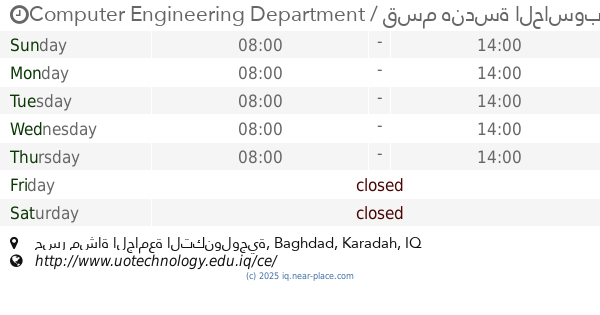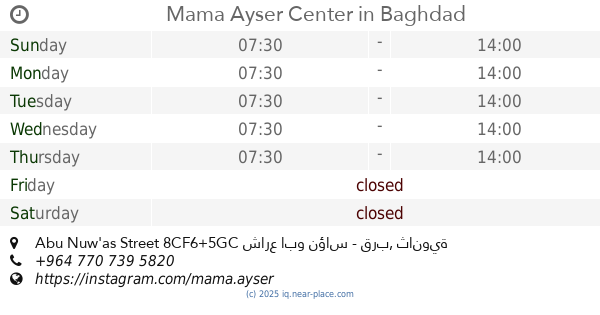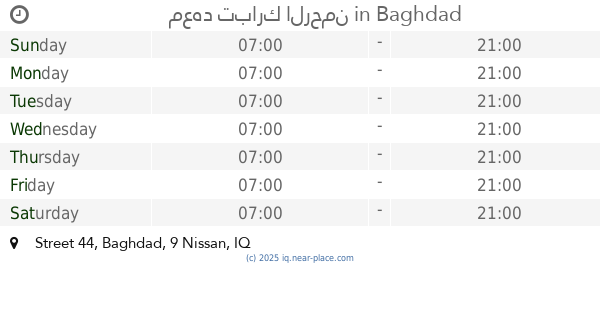closed
🕗 opening times
| Sunday | - | |||||
| Monday | - | |||||
| Tuesday | - | |||||
| Wednesday | - | |||||
| Thursday | - | |||||
| Friday | closed | |||||
| Saturday | closed | |||||
52, Wathiq Street, Baghdad, Karadah, IQ Iraq
contacts phone: +964
website: www.facebook.com
larger map & directionsLatitude: 33.3148043, Longitude: 44.4351432










زيفر / ZEPHYR
::A failed school, from the principal to all the teachers except for two, Mr. Asaad Abu Biology and Mr. Andy Abu English. Only these are beautiful.
Mohamed Ali
::My secondary school
Alkasim Azzam
::It was my school, good luck to all students
RDX. G4mer
::Good school but some teachers aren't really good but some are. Trees it's beautiful. Beautiful gardens Huge Occasions hall It needs some painting and replacing things but overall it's a good school Good school but some teachers are not really good but some are. The trees are beautiful. Beautiful gardens A hall for large events It does need some painting and replacing things but overall it is a good school
عماد محمد Imad M
::The Regular School is one of the old schools of Baghdad. It was established by the Minister Nizam al-Mulk during the time of the Abbasid Caliph Abu Jaafar Abdullah al-Qa’im Bi Amr Allah. This school had great fame and was on the Rusafa side of Baghdad. It was built and renovated in the year 459 AH/1066 AD. It was opened on Saturday, Dhu al-Hijjah 10 of the same year, and its building and construction were renewed in the year 504 AH/1110 AD. It was a school in which various sciences were taught and it was considered to be with the Mustansiriya School. It is one of the most famous schools of the Abbasid era, and it is one of the archaeological monuments that have disappeared, and its location is not known, and its drawings have disappeared. Among its relics is the minaret beacon cut off in the area under the hospice, which was demolished in the fifties of the last century, and among its relics is the House of the Qur’an, which is a room that was located in the market of Al-Bazzazin, which Mullah Ahmad bin Al-Hajj Falih used as a school to teach the Qur’an. It was demolished after that and its traces were erased, and its location, as is well known, is in the souk of sandals and it extends to the souq. Al-Attarin, currently located south of Souq Al-Saffafir. A modern preparatory school has now been built in the Al-Wahda neighborhood in Baghdad, called the Regular School, and it was named after her. Its history This school was founded by Vizier Nizam al-Mulk, one of the most famous Seljuk ministers. He was a minister to Sultan Alp Arslan and his son Malikshah. He established the Nizamiya of Nishapur and Baghdad in 1065. The Ismailis assassinated him in 457 AH / 1067 AD. Its location was on the Tigris River in Baghdad, between Bab Al-Azaj and Bab Al-Basilia. Nizam al-Mulk spent two hundred thousand dinars on its construction, built markets around it to be an endowment, and bought estates, bathrooms, warehouses, and shops to endow them. In its construction, the school took the form of a quadrilateral, and it had halls with domes, surrounding a courtyard in the middle. On the side facing Mecca, there was the prayer hall, and it contained the pulpit. In the corridors attached to the building, there were places for students to sleep. Toilets, a kitchen, and stores were also attached to it, and classrooms surrounding the school courtyard, and a library was attached to the school. Wars continued against Baghdad, and the matter of the Nizamiyya was neglected until it disappeared at the beginning of the ninth century AH / fifteenth century AD, and its location became a large district of Baghdad, and the iwan remained its door until the year 1332 AH / 1914 AD. The pumice market currently occupies the place where the school was located at the time. Its objectives The goal of the Nizamiyya school from its first inception was to remove the traces of Shiite ideas left by the Buyids and Fatimids during their rule. Hence, religious education was based on the Sunni doctrine, and according to the endowment law, the Shafi’i doctrine was spread. The text of the endowment emphasized that everyone who works in the school must be Shafi’i.